Bali: Ubud’s Saraswati Temple
After a few days at the beach we went to Ubud, which is supposed to be the cultural hub of Bali. There are temple dances of several flavors offered every night there, and extensive arts and crafts shopping. There are also art museums, but some in our party are generally opposed to them so we skipped them in favor of cafes and general exploration.
Balinese tradition demands that every village have at least three temples in it, and Ubud is in addition the traditional seat of a royal family, which built its temple-style palace on the main drag. So there are lots of extravagantly decorated and carved temples for a tourist to choose from. A short block from the palace is the Saraswati temple (Saraswati is the goddess of learning and music), which features a big lotus pond in front of the performance area where they stage Legong dances. We stayed at the adjacent bungalows, whence we had immediate access to an outer temple courtyard, where food is prepared and people hang out informally for ceremonies, and then to the inner temple, where the more formal, sacred ceremonies are held. When no ceremonies are going forward, the inner temple is where they keep the gilded gamelans (a series of xylophone-like instruments precisely tuned and hit with hammers) and gongs for the performances, and where they keep the sacred masks for the barong dances.
Here’s the gate from the inner temple to the performance area, complete with toothy guardian over the door: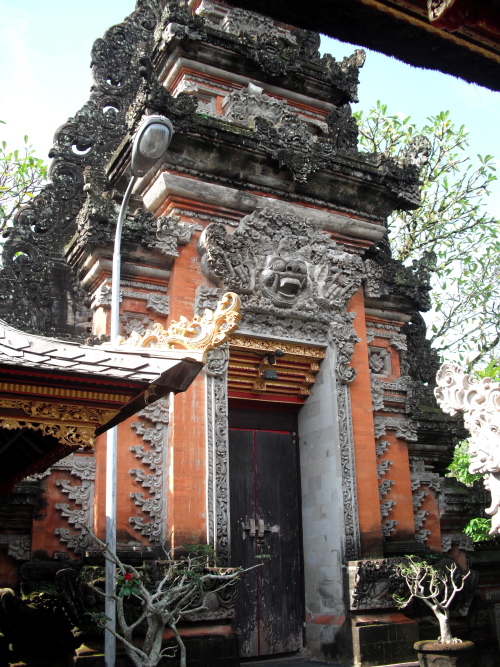
In this inner courtyard were plenty of shrines and buildings of different sizes, all thatched with a particular black palm fiber used exclusively for holy buildings. They were all open-air buildings, with carved and gilded wood pillars, and carved, painted and gilded bas-reliefs like this one:
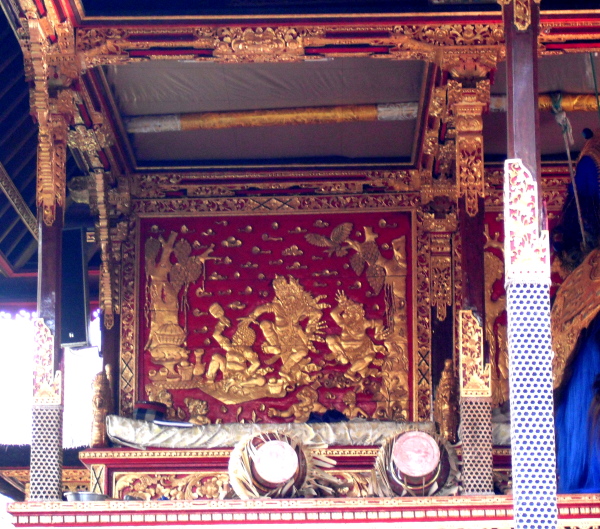 There were statues here and there, in the shrines like this Ganesh:
There were statues here and there, in the shrines like this Ganesh: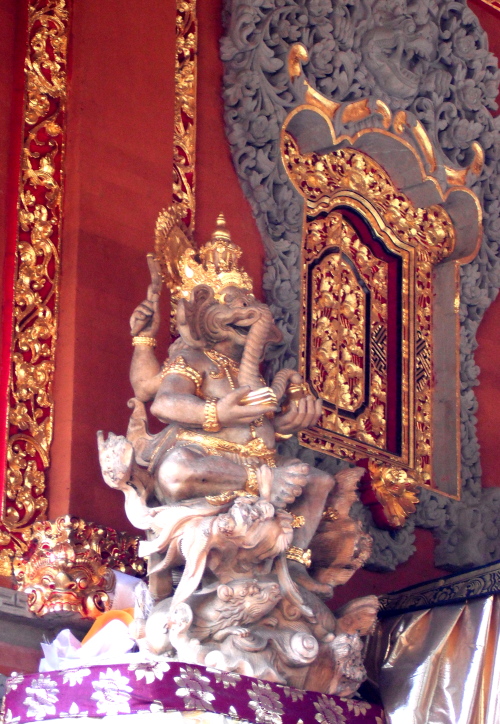 And like this fellow (I think it’s Ravana being attacked by Rama’s vulture ally while he’s abducting Sita, but I could well be wrong):
And like this fellow (I think it’s Ravana being attacked by Rama’s vulture ally while he’s abducting Sita, but I could well be wrong):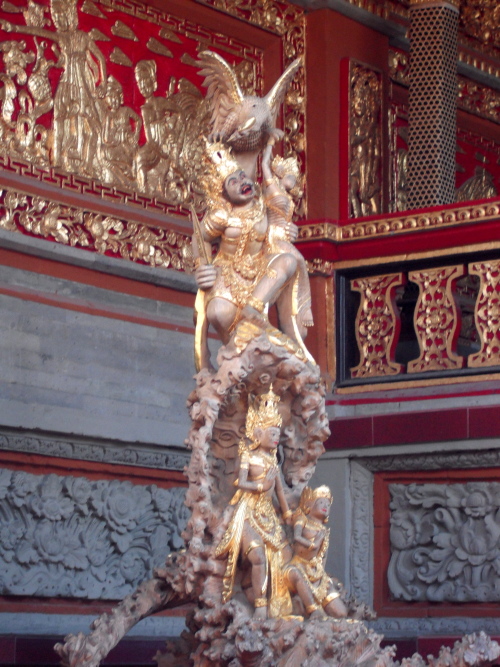 There’s one statue that is completely uncovered, and that’s Saraswati herself, complete with her sitar, goose and peacock, not to mention impressive headgear:
There’s one statue that is completely uncovered, and that’s Saraswati herself, complete with her sitar, goose and peacock, not to mention impressive headgear: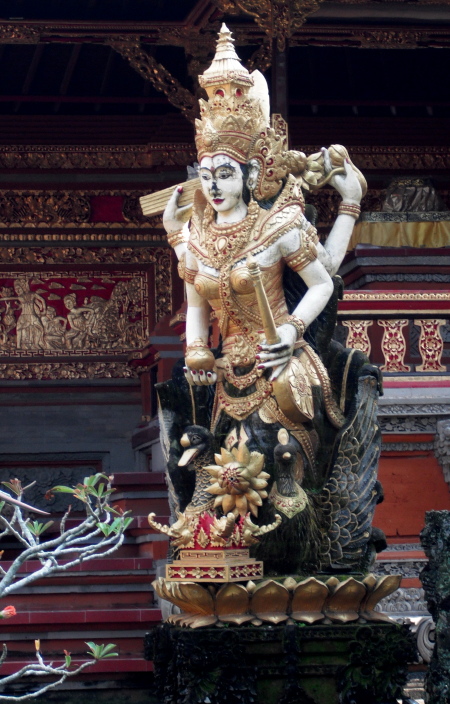
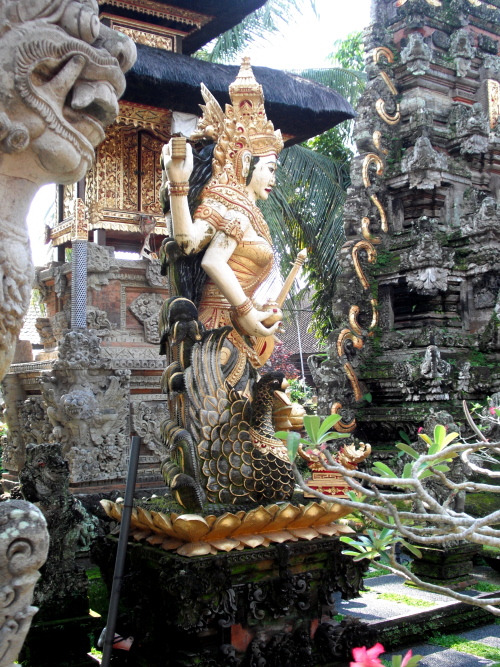 Saraswati is the main deity of this temple, so she gets two pictures. That big stupa to the right is a traditional temple structure, depicting the Balinese cosmos. At the very bottom is the turtle who holds the world on his back; the two golden snakes of human earthly needs wind their way up the sides, and at the top (not visible in this picture because the sun was in the wrong direction for photography) is the empty throne that is the symbol of the overall one god, the supreme deity Sanghyang Widi Wasa.
Saraswati is the main deity of this temple, so she gets two pictures. That big stupa to the right is a traditional temple structure, depicting the Balinese cosmos. At the very bottom is the turtle who holds the world on his back; the two golden snakes of human earthly needs wind their way up the sides, and at the top (not visible in this picture because the sun was in the wrong direction for photography) is the empty throne that is the symbol of the overall one god, the supreme deity Sanghyang Widi Wasa.
But like most inner temple courtyards, this one houses both the gamelans and other orchestral instruments for sacred performances, and the barong masks: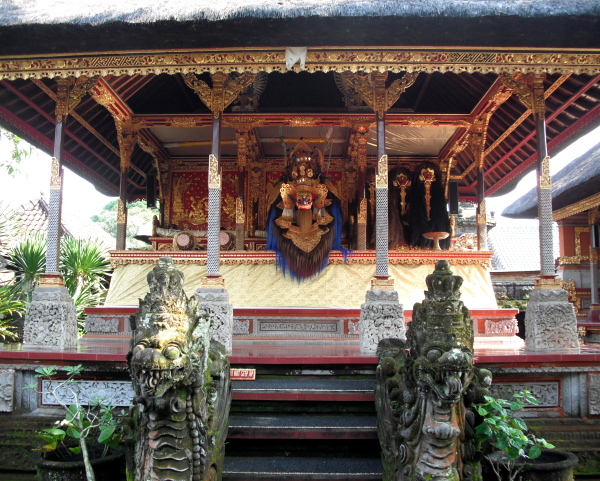 Note that the stairs to the barong shrine are guarded by the ubiquitous crowned snakes, the familiar representations of human earthly needs. The barong, from what I’ve read, is kind of an expression of the good forces guarding and infusing humans. When dormant it stays in its shrine in the temple, like this. But at particular seasons it comes to life, and then the mask is joined to a body thick with palm-fiber hairs, and the barong can go outside the shrine, and into the streets of the town itself, in dances in which it is pitted against the darker forces depicted in the masks to the right, the witch Rangda, her daughter, and a quasi-sympathetic henchwoman. Here’s a closer look at the barong:
Note that the stairs to the barong shrine are guarded by the ubiquitous crowned snakes, the familiar representations of human earthly needs. The barong, from what I’ve read, is kind of an expression of the good forces guarding and infusing humans. When dormant it stays in its shrine in the temple, like this. But at particular seasons it comes to life, and then the mask is joined to a body thick with palm-fiber hairs, and the barong can go outside the shrine, and into the streets of the town itself, in dances in which it is pitted against the darker forces depicted in the masks to the right, the witch Rangda, her daughter, and a quasi-sympathetic henchwoman. Here’s a closer look at the barong: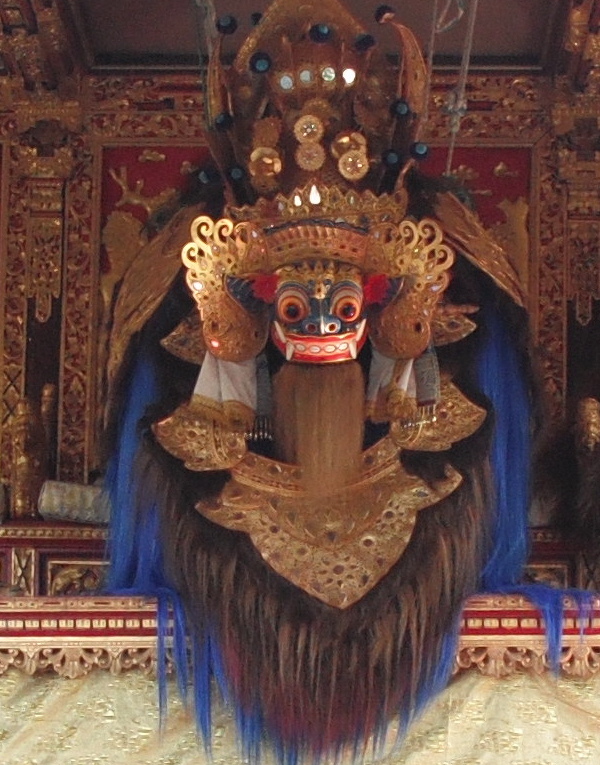 And below, the opposition, the Rangda and her buddies, with their out-of-control canine teeth.
And below, the opposition, the Rangda and her buddies, with their out-of-control canine teeth.
We actually passed a barong ceremony and dance in the street of a village outside Ubud; the barong is a two-man costume, like the Chinese lion, and it sways around in front of a lot of formally-dressed villagers sitting on the ground in front of it. We didn’t see the part where Rangda appears at the other end of the street and howls threats at Barong, but apparently that’s the drill. There’s some sort of contest between them and Rangda retreats, although unharmed; the ceremony depicts the balance of opposing forces – a balance that everyone prays for in Bali, rather than the vanquishing of evil. And evidently when not brought to life for the season of battle dances, the barong and Rangda dwell pretty peacefully side by side.
Have I mentioned that temples in Ubud are places of beauty? Of course in Bali beauty is everywhere, in the scenery, the ocean, the flowers and jungle everywhere, the rice paddies and volcanic landscape, and in the little food- and flower-filled offerings provided at every little shrine, every big rock and tree of note. And in the Saraswati temple they make sure that orchids add to the grass and pavements, the carving and gilding, the lotus pond and music: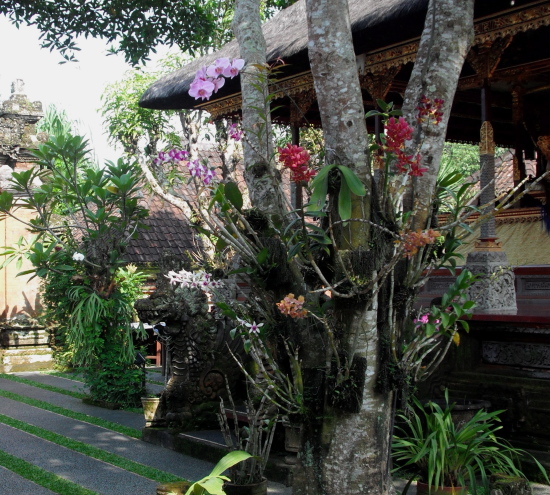 It’s a lovely place.
It’s a lovely place.
